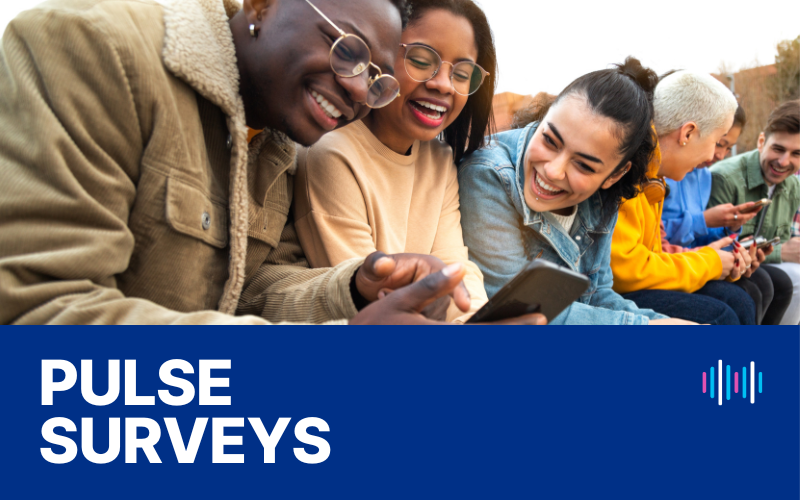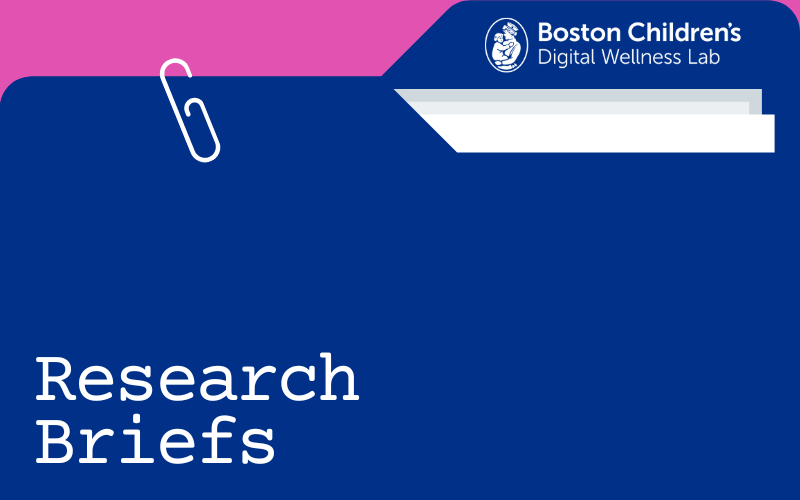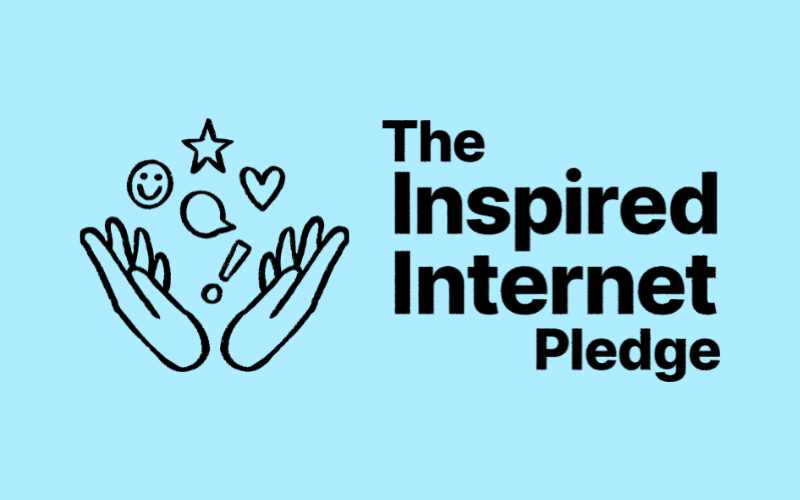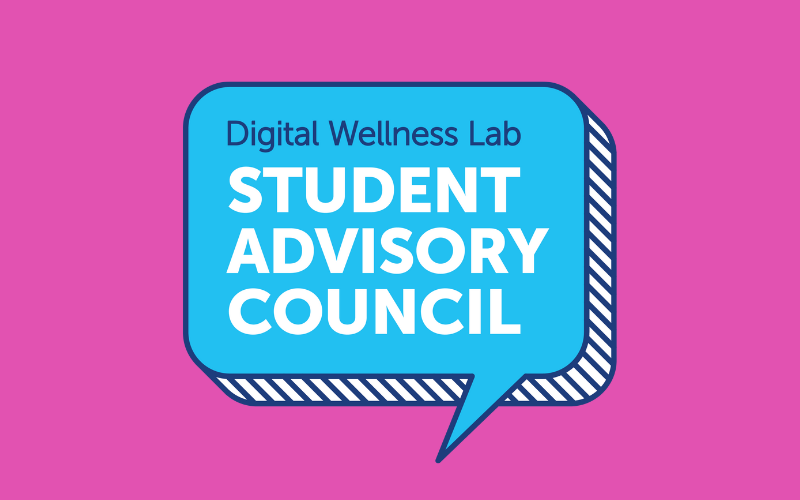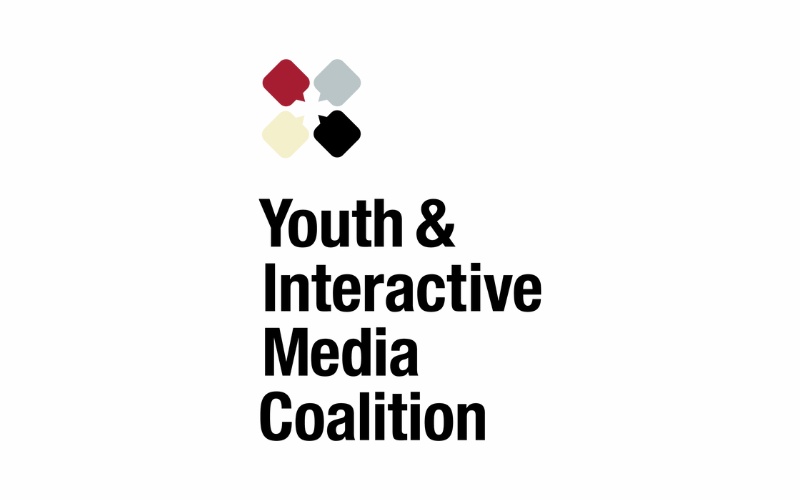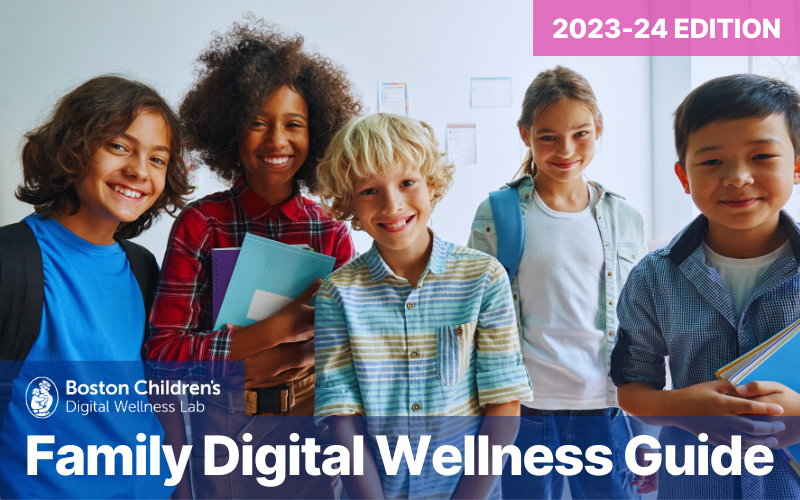On Tuesday, May 16, the Digital Wellness Lab’s inaugural Student Advisory Council (SAC) of 10 high school students met over Zoom with an audience of 40 tech, media, healthcare, and education leaders. These 10 students were selected from a range of applicants, and hail from all over the United States – Louisiana, South Carolina, New York, Massachusetts, Maryland, Virginia, and California.
In monthly meetings since October 2022, under the guidance of advisors from the Digital Wellness Lab, the students covered a range of topics like digital wellness, platform safety, sourcing and research methodology, and teen mental health, with presentations from special guest speakers like Dr. Michael Rich, Kristelle Lavallee Collins, and Dr. Keneisha Sinclair-McBride. The Council members also served as an essential sounding board for the Lab’s research team, offering feedback on pulse survey questions and other research projects. Finally, throughout the course of the academic year, the members of the SAC had been working in small groups on projects of their choosing. Those projects came to fruition on Tuesday night. Each group (three in total) was allotted twenty minutes to present on a media-related topic that was important to them, and engage in Q&A sessions with attendees. The presentations ranged in topic and format, highlighted below:
Representation on Social Media
Presented by: Khufu Holly, Jr., Jayla Johnson, Stephanie Boye-Doe, and Eliase Kiflezghie
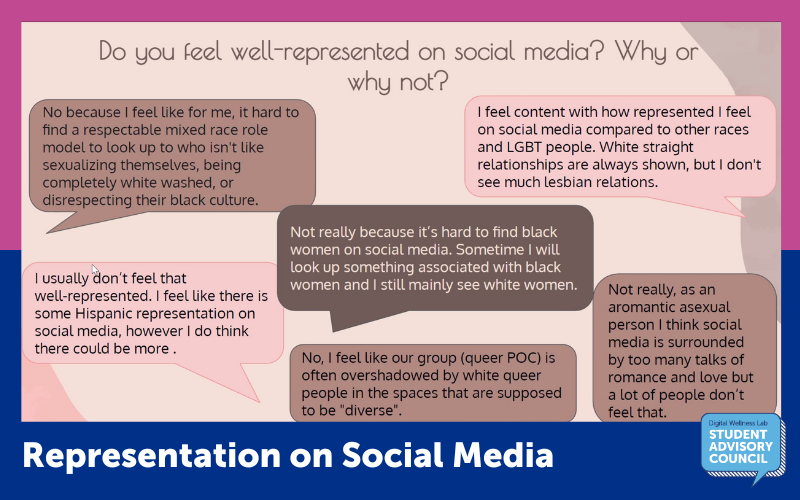
First up were Khufu, Jayla, Stephanie, and Eliase, who chose to focus on representation on social media. When coming up with their topic, the students in this group spoke at length about their own experiences of not seeing people with their shared identities well-represented on social media. They were frustrated about the shadowbanning of BIPOC creators and about having to actively seek out content that is relevant to them, and had seen the impacts of a lack of representation and the dissemination of misinformation on social media in their own lives. After explaining their individual motivations for pursuing this topic, they provided some background, asserting that despite the diverse makeup of the U.S. (citing census data), many social media platforms don’t reflect this diversity on their explore pages or feeds. And because teens use social media for so many things (e.g., communication, learning, connecting with others) and social media can impact identity and sense of self worth, it is a topic of great importance.
To explore if their peers felt similarly to them, this group developed and conducted a survey. The survey asked a range of questions about how diverse people felt their platform feeds to be, if they had to go out of their way to find content that represented them, and if there were instances when content on social media negatively impacted how they felt about their identity. They found that race, gender, and sexual identity all influence how youth experience social media. Half of the sample felt that their identities are well represented on social media, though they made the observation that 52% of their sample were white. The majority of their respondents (72%) agreed that social media platforms should do more to uplift diverse groups of people.
Recommendations: Representation on Social Media
- The group elevated the voices of their peers by sharing some of their open-ended responses, which were teeming with frustration and a desire to be seen in the spaces they spend their time. They also noted that people with intersectional identities have more difficulty finding positive representation. Their presentation culminated with recommendations for social media platforms to help diverse communities feel seen.
- Change the algorithm to push diverse creators (especially on Explore/For You pages)
- Support diverse communities after their period of prominence (e.g., Black people after Black History Month)
- Improve reporting services to make reporting hate speech and misinformation easier
- Put misinformation warnings and fact checking resources on posts
In the Q&A section of their presentation, the group thoughtfully answered questions about the places they go online to feel more represented or avoid fabricated content, and how they determine what is misinformation. These young people highlighted places where they can curate their experiences and appreciated having the opportunity to note which content they disliked. They celebrated blogs and news sources that highlighted diverse communities and contained carefully verified information. Finally, they advocated for easier reporting strategies on platforms, implying that platforms should be better at responding when multiple users have deemed something as harmful.
Misinformation on Social Media
Presented by: Jose Santana, Nylah Jordan, and Damilola Abiodun
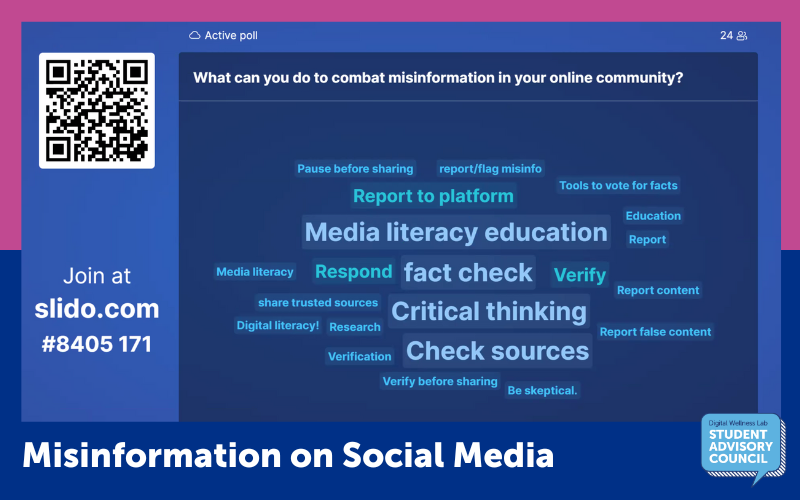
Next up, Jose, Nylah, and Damilola engaged in a panel discussion (facilitated by DWL Clinical Research Specialist, Emily Izenman) about misinformation on social media. First they defined misinformation as false and misleading information, and explained that it spreads in a number of ways, including word of mouth, sharing posts or images on social media, through podcasts or videos, and by bots. They noted that although things typically spread faster online, it is a problem offline as well. They discussed the motivations for spreading misinformation, noting that while some people do it on purpose, oftentimes there is no bad intention, and people really believe it to be true. This is why combating misinformation is so important — individuals are susceptible to the facts being presented in misinformation, and youth don’t always have the skills to tell the difference. When people act upon the wrong information it can be harmful, and instances of spreading misinformation are far too common.
Jose shared an example from his own life that exemplified the prevalence of misinformation. He saw a post on Twitter that contained a Reddit screenshot about Discord changing their privacy policy, asserting that Discord was removing protections and were going to record their video calls, voice calls, and channels including screen shares. Naturally people were upset; however, upon doing some digging, Jose found that although Discord had recently changed their privacy policy, they had not removed these protections, and had addressed the confusion around new language. This example highlighted how misinformation spreads from platform to platform, and how it can stem from something that has some truth to it.
The group noted some common characteristics of misinformation, including exaggerated statistics or language, misleading headlines, and factually incorrect information, and explained that some misinformation is meant to play on emotions or biases.
Advice for combating misinformation online
To combat this, they gave the following advice:
- Check the source and the author
- See if it’s being reported by other sources too
- Maintain a critical mindset
- Check your own biases
- Consider if it is satire
- Use a fact checking website
Then they opened it up to the full group to gather their thoughts using an online survey tool. Attendees responded to the question What can you do to combat misinformation in your online community? As people entered their responses, a word cloud emerged, with the most agreed upon ideas being media literacy education, fact checking, reporting to the platform, verifying, checking sources, responding, critical thinking. When asked how much people’s preconceived notions play into people’s conception of misinformation, Nylah explained that people are more susceptible to things they already believe to be true, and they might be less willing to counter it if they already agree. However, she noted how important it is that people understand what they’re consuming on a daily basis. The students in this group agreed that media literacy education is crucial.
Regulation of Screen Time on TikTok
Presented by: Sydney Wong, Rome (Roman) Di Giulio, Christina Astrid Sime
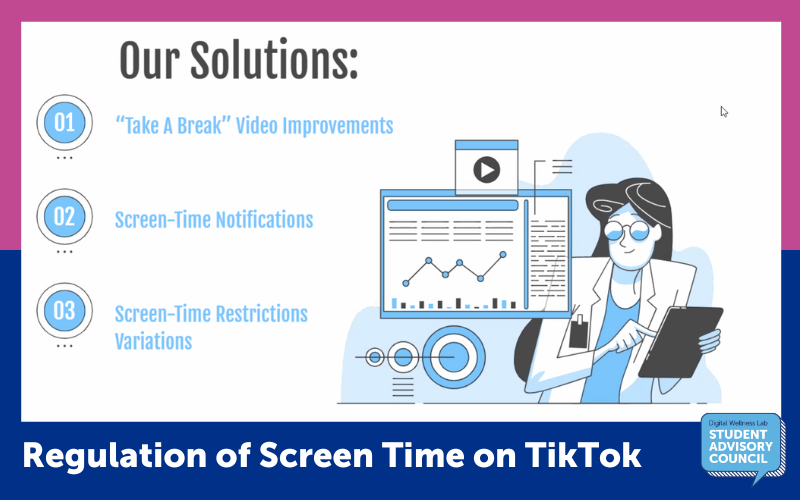
Finally, we heard from Sydney and Rome (their group member Christina was unable to attend this part of the meeting), who chose to focus on how teens regulate their TikTok use. Interestingly, none of the members of this group are active TikTok users; however, it was their own previous experiences with the platform and a presentation by a TikTok employee at one of the early SAC meetings that prompted their interest in the topic. They started their presentation by noting the pressures of a social media presence and the challenges teens are facing regulating their individual media use, and offering a mission statement:
“We want to create a safer, more regulated environment where teenagers can navigate the digital world without the negative repercussions on their developing brains.”
Understanding that creating a safe environment is a big task, they chose to focus specifically on doom scrolling on TikTok. They wanted to see if teens were aware of their screen time, and if “Take a Break” videos, one of TikTok’s strategies for self-regulating media use, were effective. To explore this topic, they conducted a survey across their three high schools. Of the respondents who used TikTok (100 out of 193), they found that nearly half used it for 1-2 hours per day and over half described their use as mildly or very unhealthy, citing the time they spent on the app. Nearly 80% of those respondents had seen the “Take a Break” videos, but only about 10% of them would leave the platform when they saw them, implying the strategy is not as effective as it could be.
Solutions for tackling the issue of doom scrolling on TikTok
- Improving the “Take A Break” videos (e.g., making them unskippable, utilizing timed intervals, and diversifying the content to make them more engaging);
- Screentime notifications to make them aware of how long they’ve been scrolling; and
- Screen-time restriction variations (e.g., app lock, configurable intervals, and a hard stop function).
One of the attendees from TikTok was texting their colleague who designs the well-being features, noting that these suggestions were coming straight from the kids.
When asked what was stopping teens from being able to reflect and regulate their own use, the group noted that that the allure of phones and apps is very real, and it’s challenging to be so accessible between text, email, and social media. They encouraged the people who design apps to be aware that this is the users’ experience, and to design thoughtfully.
General Q&A
After the presentations, the members of the Student Advisory Council answered questions from the audience. They discussed the tension between regulation and invasion of privacy, explaining that rules around social media should be negotiated between the child and the parent.
They also advocated for more conversation around healthy social media use and media literacy education in schools (since it’s where kids are spending so much of their time), suggesting that it could be incorporated into health classes. They also noted the importance of educating parents.
Dr. Michael Rich offered the idea that youth could develop their own wellness videos about digital well-being for delivery on social media platforms, stating, “One of the best ways to become media literate is to make media and to understand how one goes at media with an intent to tell a story, to make a point, and how one puts that together affects how you read and deconstruct the media you’re receiving as well.” The SAC members agreed that students seeing other students doing these videos could get them more engaged.
Looking to the Future
The event ended with a look to the future. Each SAC member responded to the question: Where do you see social media and interactive media five years from now? What do you want that space to look like?
Some of the teens felt that its format might not be too different from how it is right now, while others felt that it would actually change quite a bit (one student noted the rapid popularity of TikTok) as people continue to innovate. Some hoped for better rules and regulations around privacy and cyberbullying. Others hoped that it would be less of a focus, not daunting or draining to users. There was resounding agreement, however, on what they wanted online platforms to be in five years time — spaces that are safe and inclusive, that create community, celebrate diversity, foster empathy, encourage the exchanging of ideas, inspire creativity, and allow people to connect.
Despite all the challenges and nuances they had tackled in their presentations, the ultimate message of this group of young people was one of hope for a better world, online and off. We can sleep better knowing the future is in their hands!
This convening was a wonderful opportunity to elevate youth voices. The members of the SAC readily seized the opportunity to have the ear of individuals from prominent organizations (e.g. TikTok, Snap, Inc.) with whom they would not otherwise cross paths. We are so proud of them for all their hard work, and for being such poised, engaged, and thoughtful individuals. We cannot wait to see what next year’s Council has in store!

